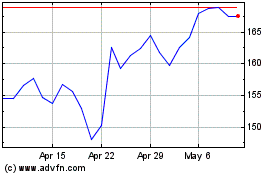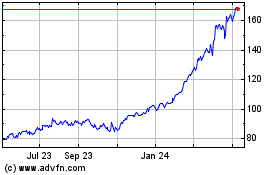By Greg Ip
At the peak of the tech bubble in 2000, Microsoft Corp. jockeyed
for the title of world's most valuable company with Intel Corp.,
which made microprocessors; Cisco Systems Inc., which made
communications gear; and General Electric Co., which made
locomotives and turbines.
Nearly two decades later, Microsoft is once again atop the
market-value rankings. Cisco, Intel and GE are -- combined -- worth
about half of Microsoft. This signifies a profound shift in the
economy in recent years. Productivity and economic growth
increasingly flow not from equipment, buildings or computer
hardware, but from instructions, processes, coding and data: in
other words, software.
Nearly eight years ago, venture capitalist Marc Andreessen
wrote: "Software is eating the world."
Software programming tools and Internet-based services such as
cloud computing, he argued, enabled start-ups to displace
incumbents by digitizing everything from phone calls and cars to
retailing and film distribution.
Like-minded technological evangelists have long argued
artificial intelligence, machine learning, big data and other
technological advances were about to unleash a new boom. But the
boom refused to show: growth in productivity -- the best measure of
how technology enhances worker output -- remained mired near
generational lows.
Recently, however, there have been intriguing signs a boom may
be in the offing. In the first quarter, American companies for the
first time invested more in software than in information-technology
equipment. Indeed, outside of buildings and other structures,
software surpassed every type of investment, including
transportation equipment such as trucks and industrial equipment
such as machine tools. Software spending is even higher if the cost
of writing original software programs, now classified as research
and development, is included.
Adjusted for inflation, software investment grew 11% from the
first quarter of 2018 through the first quarter of 2019. By
contrast, investment in equipment grew less than 4% and in
structures, just 1%. (Revised data are due out Thursday.) The
headwinds buffeting capital spending broadly, whether the waning
tax cut, trade war or slumping commodity prices, have largely
spared software. Meanwhile, productivity growth has picked up to
2.4% in the past year, the fastest since 2010.
Whether that can continue is debatable: business investment and
productivity growth appear to have slowed in the current quarter.
Nonetheless, a recent survey by Morgan Stanley & Co. found
chief information officers planning to boost software budgets this
year by 5%, and hardware budgets just 2%. Their main target is
cloud computing, under which businesses pay external providers to
host their data and supply tools to analyze that data.
Microsoft years ago wouldn't have been seen as an obvious winner
from this shift. Long reliant on Windows and its Office software,
it had flubbed the transition to web-based applications, mobile and
search. Amazon.com Inc. grabbed an early lead in offering cloud
computing as a standardized service to the public. In his 2011
article Mr. Andreessen said Microsoft was "threatened with
irrelevance."
After Chief Executive Satya Nadella took the company's reins in
2014, Microsoft shifted focus to cloud-based services. Dubbed
"Azure," the services now account for half of the company's
revenue. Microsoft lacks the hipness factor of consumer-facing
Amazon, Alphabet Inc.'s Google and Apple Inc. Yet it has achieved
comparable growth by making itself a partner for businesses bent on
"digital transformation," a nebulous term that means using
technology to remake processes or products.
Starbucks Corp. uses Azure to centrally monitor coffee machines
for everything from the type of bean to coffee temperature and
predict needed maintenance. The company used to deliver new coffee
recipes manually by sending USB thumb drives to 30,000 stores. Now,
they are delivered through the cloud. The Starbucks mobile app uses
a type of machine-learning system hosted by Azure to show customer
recommendations based on store inventory, weather and the user's
order history.
If there is a constraint on this boom, it's that software is
harder to get right than hardware. Because big companies often
customize or design their software in-house, their success may be
difficult for others to replicate. A study by James Bessen at
Boston University found that companies that invest more in
proprietary information technology enjoy faster profit growth,
higher revenue per employee and wider profit margins. Smaller firms
struggle to compete against those advantages, which Mr. Bessen says
is why economic activity has become concentrated in fewer
firms.
Cloud computing could alter that equation by extending
capabilities currently the preserve of big companies to small and
medium-size firms. Libbey Inc., a Toledo, Ohio, manufacturer of
wine glasses, tumblers and other tableware with 6,000 employees and
six factories worldwide, is replacing multiple sales, finance and
production computer systems with a single cloud-based system from
Microsoft that will enable employees to see the entire company from
anywhere in the world. The benefits will include faster response by
salespeople to customer requests, reduced inventory and less manual
processing of transactions, says James Burmeister, Libbey's chief
financial officer.
Libbey can buy most of the necessary software "out of the box"
from Microsoft without having to "make any custom code," he says.
However, Libbey will likely need programmers and data scientists to
design and optimize tools to analyze the data that Azure gathers,
using its algorithms to squeeze the cost out of making glasses. "We
want to get rid of the manual task at the bottom of the food chain,
and elevate the work of our people into...running the business
better," he says.
There's no guarantee the money now being plowed into software
will achieve the kind of payoff that hardware did two decades ago.
But at least it's headed in the right direction.
Write to Greg Ip at Greg.Ip@wsj.com
(END) Dow Jones Newswires
May 29, 2019 10:58 ET (14:58 GMT)
Copyright (c) 2019 Dow Jones & Company, Inc.
GE Aerospace (NYSE:GE)
Historical Stock Chart
From Mar 2024 to Apr 2024

GE Aerospace (NYSE:GE)
Historical Stock Chart
From Apr 2023 to Apr 2024
